
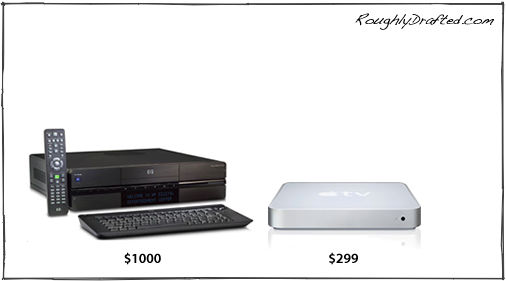
Readers Write About Media Center, Apple TV, HDTV
Responding to Windows XP Media Center Edition vs Apple TV and Apple TV: iTunes Store Movie Quality vs DVD, HD, Cable, readers wrote about the history of WebTV, Microsoft’s Media Center and Extenders, HDTV bitrates, broadcast technologies pushing the state of the art, and Apple TV’s dependence on widescreen displays.
How Microsoft Killed WebTV
The original article described the history of Media Center, which followed Microsoft's purchase WebTV, a startup co-founded by Bruce Leak, the former lead developer of QuickTime at Apple. What WebTV was working to deliver and where Microsoft wanted it to go ended up being very different.
Reader GO wrote with an inside look at why WebTV died. "I used to work for WebTV and then WebTV/Microsoft. I now work for Apple, and way back in the day NeXT, just so you know my biases," he explains.
WebTV was a dedicated terminal designed to offer a service deployed using Sun Solaris servers. Microsoft decided to copy its early 90s PC strategy--of replacing dumb terminals with PCs running Windows and Terminal Server--and set to work both to migrate WebTV's Solaris service to Windows NT, as well as converting its RISC WebTV box into a stripped down PC running WinCE.
Subscriptions Not the Cause of Death
The article had stated, “under Microsoft, WebTV continued as a subsidized box sold under a subscription plan. Signing up long term users ended up being nearly impossible, and the churn of short term subscribers meant the company was losing money handing out free hardware and never recouping enough subscription fees.”
But it wasn't really the lack of subscription revenues that killed WebTV, says GO, explaining, "WebTV was profitable. It is true that they initially sold their product at a loss with the intent of making up their losses with subscriptions, but within months after the Microsoft purchase, a combination of cost-reduction in hardware and efficiencies behind the scenes made WebTV fairly profitable.
“They did have a hard-core fan base of subscribers (mostly older adults) who kept with the subscriptions long after internal WebTV/Microsoft predictions assumed they would churn away."
A Lethal Transition
Instead, it was a rethinking of WebTV’s entire business model to suit Microsoft’s plans that killed it. "WebTV wanted to be a product/service company. Microsoft wanted WebTV to be a platform. They wanted to sell it to cable companies and telcos and everyone. 'Install this CD and you can have your own set-top box empire.'
“But they couldn't sell such a thing as a Solaris product, so they sucked away all WebTV's resources trying to port the service onto Windows NT 4. 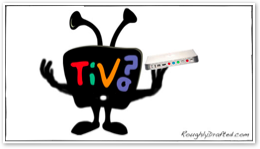

“Additionally as they courted these cable companies etc, each had their own special requirements: 'I would buy that from you if it did this...' so not only were the developers on the fools errand of trying to take a stable Solaris based service and run it on NT4, but the features and requirements of the NT system continually changed. This means that service never really materialized, and the original product rotted with no new features or hardware for a long time.”
UltimateTV Ultimately Canceled
“The Microsoft UltimateTV DVR was essentially designed by WebTV before the Microsoft purchase,” GO wrote. “It was superior to Tivo and ReplayTV when introduced, but Microsoft killed it--for unknown reasons--before ever shipping the most interesting [UltimateTV] products.
“I don't really know why they dropped it. I was working on a different set of software at that time, and was not privy to those conversations. Maybe they decided there wasn't a clear enough market for it. TiVo certainly has only barely managed to stay afloat financially with their product. Perhaps they decided that Windows Media Center made more sense somehow. It was too bad regardless.”
WebTV To WinCE: Too Little Too Late
In addition to porting the service end to NT, Microsoft also turned the WebTV box into a WinCE PC. As GO described, "WebTV wrote its own client operating system, and was essentially just a web browser which talked to the service; all the intelligence and look and feel were done on the server side.
“Even though WinCE had slightly steeper hardware requirements, it meant that it would be much easier for third parties to make peripherals for such a widely known OS. Where Microsoft screwed up with WebTV was pulling their engineers away from making new versions of WebTV and UltimateTV and spent effort porting the WebTV box to WinCE, and the service from Solaris to NT. This is while constantly changing the feature set, and killing off new DVR-like products before they shipped.
"By the time they finally shipped a new product as MSNTV2 in 2003 or so, they introduced a product that was essentially the original WebTV product, one that made sense in 1996 with very few new compelling customer-visible features for the modern world."
The DVR Recycled as Media Center, with Extenders
That also left Microsoft with a failed investment in DVR technology, painstakingly rewritten to work on a Windows PC. Microsoft initially tried to sell it as a premium version of Windows XP, and has since bundled it in the premium versions of Windows Vista: in Home Premium and the Ultimate version.
Coupled with this premium version of Windows featuring the Media Center application, Microsoft began selling the idea of a Media Center Extender, to be used to relay content from a Media Center PC to an external box connected to a television. There are two kinds:
-
•Third party Media Center Extenders by HP and Linksys, now discontinued
-
•Microsoft’s Xbox 360
Third party Media Center Extenders were Windows CE based set top boxes which use Windows Remote Desktop Connection--essentially Terminal Server--to create a Windows session on a Media Center PC. The Xbox 360 is different in that it can play fancier transitions and some other content formats only supported in Vista.
The article identified a key difference between Media Center Extenders and Apple TV: Microsoft requires the content be on a special Media Center PC, while Apple TV works from any computer running the free iTunes, on the PC or Mac. That means buyers looking at both options would need to factor in the cost of buying an entire new Media Center PC setup just to use the Xbox 360 in the capacity of an Apple TV.
Not so, claimed Richard Lawler, writing, “your facts are quite lacking. The XBox 360 is a Windows Media Center Extender, but it does not require Windows Media Center for video or audio streaming. The XBox 360 can play video or audio streamed by any PC running Windows XP or Vista and Windows Media Player 11 or a Mac running 360Connect.”
According to Microsoft, however, that's not true. In its Media Center Extender FAQ, Microsoft states:
-
•Q. Can I use Media Center Extender with any Windows XP-based PC?
-
•A. No. You must have a Media Center PC running Windows XP Media Center Edition 2005 to operate the Media Center Extender.
With the Xbox 360 and Microsoft’s Zune software, users can update their 360 with new firmware which allows the Zune software to share content from within Windows XP without Media Center, but that helps to explain why nobody is doing it.
Ironically, the open source Xbox Media Center, a GNU project that allows the original Xbox to stream and share content freely from a variety of sources, requires the illicit use of hardware mods and can not be legally distributed, since it requires Microsoft’s XDK to run and is hung up on several patent issues.
Microsoft obviously wants users to buy new premium Windows Media Center PCs, and now hopes that Media Center features in premium versions of Vista will spur upgrades. Why give it away for free when users will pay?
When is HD not HD?
Andrew Blackburn writes, “Your comments about the dithering of the standards-makers are spot-on. I'd rather have 720p everywhere now than 1080-something-someday-somewhere-maybe.
“In fact, the decision to split HDTV up into so many little pieces and parts has left it almost impossible for 'normal' people to have any clue what it is they're getting, made it expensive and difficult for media providers to create content, and has left early adopters with hugely expensive gear that won't work: people who bought HD TVs and projectors without HDMI inputs.
“HD would be a much easier sell if you could just tell people ‘HD’ or ‘not HD.’ Instead, we get arguments about whether 480p is really HD or not and 'what kind of HD' does this TV or DVD player support. Thanks a lot guys; it's lots of fun trying to explain the intricacies of different types of HD to non-technical people like my 65-year-old mother-in-law; people who just want to turn on a TV and have it, you know, work, they way it did for 70 years.”
HD Bitrates in Broadcasting
Steve Mathesius writes, “I enjoy your RoughlyDrafted articles very much. I have one clarifying point to make on a recent article. In the iTunes store movie picture quality article there is misleading information related to video bitrates. In that article you cite 80 Mbps as an MPEG-2 HD bitrate, and 25 Mbps as an H.264 HD bitrate.
“I work in the IPTV industry with both MPEG-2 HD and MPEG-4 AVC (H.264) real-time encoders. A common bitrate for MPEG-2 HD over the air broadcast signals, as you might get from an antenna receiving your local ABC affiliate, is 19.7 Mbps.
“MPEG-2 HD distribution bitrates by cable and satellite providers is often somewhat lower than 19.7. I've seen MPEG-2 HD bitrates as low as 13 Mbps. I've heard rumors some providers push it down to 10 at times.
“Using MPEG-4 AVC, or H.264, we are able to achieve bitrates as low as 6.5 Mbps today. Practically speaking, MPEG-4 AVC bitrates range from 6.5 to 10 Mbps. I expect these bitrates will continue to drop over the next two years. Tandberg TV and Scientific-Atlanta are two industry leaders at achieving low bitrates while maintaining high quality. 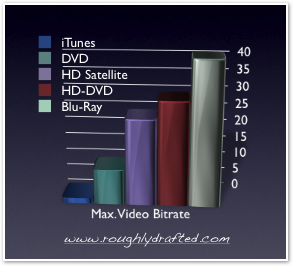

“In any case, MPEG-2 HD bitrates are more like 15-20 Mbps rather than the 80 cited, and MPEG-4 AVC (h.264) bitrates are more like 7-10 Mbps, rather than the 25 cited.”
The numbers cited in the article are the maximum bitrates supported by the standard, so it's great to have real-world figures of what is achieved in actual use.
iTunes Video Quality vs Satellite TV
What about iTunes? The article stated that “iTunes' original TV quality was superior to the video that wowed the crowd when MPEG-2, direct broadcast satellite first appeared in the US from DirectTV.”
Jeff Brown, who ran the Broadcast Technology Lab when DirectTV was originally launched in 1994, wrote in with a correction on that point:
“We always broadcast 480-line video. In 'square pixel' terms you could think of it as 640 x 480. For about the first year, we broadcast in what was informally known as MPEG-1++, which is to say, a pre-standard version of MPEG-2. It was pretty primitive by today's standards but definitely not 320x240.”
An earlier source stated that DirectTV used 352 × 288 low profile MPEG 2 at around 4 MBit/sec, but as Brown explains, “I'm pretty sure that no actual TV channel ever went below 480 scan lines, and 352 pixels per line is low enough that it's hard to read text on lower-third supers, so I doubt it.
“Sometimes people in analog TV talk about line pairs. For example, it's often said that VHS tape has about 240 horizontal line pairs, which means 480 pixels of horizontal resolution at some limited contrast ratio between any two adjacent pixels.
“As to the bit rate, 4 Mbits/sec was a fairly common average for many channels in 1995/1996, after converting to the final version of MPEG-2. In the first year or so, the bit rate tended to be closer to 7 Mbit/sec because there weren't as many channels and the encoder software was still maturing. You can scarcely believe how much MPEG2 encoders have improved in the last dozen years.”
Statistical Multiplexing, Variable Bitrates, and iPod Video Encoding (Oh My)
“As an interesting aside,” Brown wrote, “most standard definition satellite channels today run at an average visual data rate of about 2 Mbps. A process known as statistical multiplexing gives more bits to the channels that need them from one moment to the next.
“Since MPEG-2 is about 12 years old, today's encoders are extremely good. And when you're serving over 12 million customers, you can afford to buy the best real-time encoders in the world.
“Apple's iPod-friendly H.264 video looks pretty good but it's not as good as the stuff you can generate yourself in QuickTime at the same data rate. It had to be dumbed down a bit to play on iPods. Full-blown H.264 with multi-pass encoding can do pretty amazing things with not many bits, but it's too compute intensive for today's pocket devices.”
Statistical multiplexing is similar in principle to variable bitrate encoding, as Brown further explains:
“A VBR video encoder looks across a series of sequential video frames and figures out where it needs to spend more bits because the scene is changing rapidly and where it doesn't need as many bits because the scene is more static. A statistical multiplexer does the same thing but it adjusts bit rates between TV channels.
“Satellites have a number of transponders, each is a radio transmitter with some fixed amount of bandwidth. Effectively each transponder is a one-way data pipe. If a certain transponder is carrying, say, 14 TV channels, you could give each channel exactly the same number of bits as all the others.
“But if there's suddenly a lot of action on a channel, it might not have enough bits to make the picture look good. At the same time, there are probably other channels that have more bits than they need because their video isn't changing much. A statistical multiplexer juggles the bits among all these channels moment by moment so every channel on the transponder gets the bits it needs.
“A VBR encoder balances bits across time, a statmux balances bits across channels. Satellite TV uses both technologies simultaneously.”
HD Downloads from iTunes?
How long will it be before Apple offers HD content in iTunes? While Apple already offers around 75 movie trailers in full 1080p HD, the size of those two minute clips help explain why iTunes movies aren't yet ready. The three quality standards offered for trailers nearly double in size at each step:
-
•480p: ~ 20-50 MB
-
•720p: ~ 90-100 MB
-
•1080p: ~ 140-180 MB
Those numbers vary upon the complexity of the content being compressed and the quality of the compression, but they show how quickly data rates add up when pushing higher resolution. How much difference can viewers see? That question is not as obvious as it might seem, and will be considered in a future article.
At any rate, as Mathesius and Brown point out, the broadcast industry is pushing compression technologies and codec optimizations; those advances will help deliver higher quality content over the web as well. Apple is establishing a delivery platform; what gets delivered through it will progressively increase.
Why is Apple TV for Widescreen Sets Only?
Guy McLimore of CouchApple.TV writes, “this leaves me wondering why Apple tied the [Apple TV] product so strongly to HD widescreen TVs only. Why not make the Apple TV compatible with the vast number of standard definition TVs out there?”
Existing 'standard definition' TVs use analog signals to deliver compatibility with standards defined in the 1940s. For Apple to support existing TVs, it would need to make everything appearing on the Apple TV look presentable on sets only ever conceived to support basic video, not sharp text.
As anyone who has used TV output from a computer knows, standard TV is pretty poor quality, not just because of its lower resolution, but because it uses analog circuits based on really old technology.
By drawing a line at sets that minimally support 'enhanced definition,' Apple can ensure that everything the Apple TV presents looks great.
For users who don't need anything more than the TV they already use, the iPod and video dock connector make a suitable way to watch video, podcasts, and downloaded movies. Another alternative is to simply directly connect a laptop or desktop with S-Video support to a TV.
Pulling the Plug On SDTV Broadcasts
Remember that old TVs are slated to lose their analog broadcasts in 2009, although that date keeps slipping. By pushing users to adopt modern HDTVs supporting standard digital inputs that provide not only higher resolution, but a far nicer picture quality overall, Apple is positioning its Apple TV as a future-proof platform.
That's similarly to why Apple is also pushing AirPort Extreme Wireless N as a superior distribution standard over the existing AirPort Wireless G/B, even if it may be possible to force older equipment to work occasionally in some circumstances.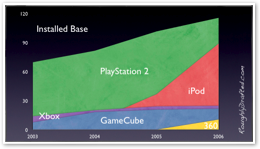

It also recalls the principle of installed base and product lifetimes mentioned in Market Share vs Installed Base: iPod vs Zune, Mac vs PC. There are hundreds of millions of TVs, but the majority of users interested in Apple TV are likely to have already upgraded to modern widescreen sets.
Those who haven’t will be better served by upgrading rather than being given a compatible, but inferior product that with extra costs to support analog video.
Like reading RoughlyDrafted? Share articles with your friends, link from your blog, and subscribe to my podcast!
Did I miss any details?
Next Articles:
This Series


 |
|
 |
|
 Del.icio.us |
Del.icio.us |
 Technorati |
About RDM |
Forum : Feed |
Technorati |
About RDM |
Forum : Feed |

Thursday, March 22, 2007





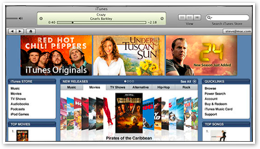

 Send Link
Send Link Reddit
Reddit Slashdot
Slashdot NewsTrust
NewsTrust





